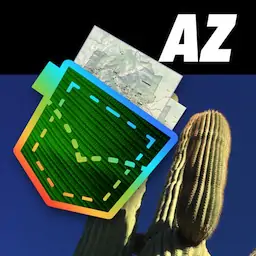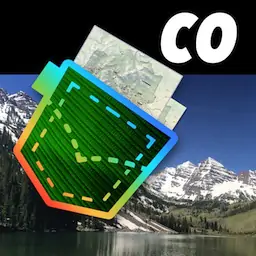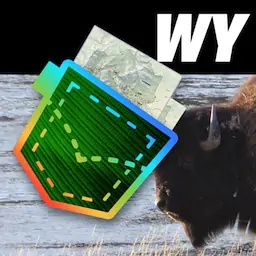Missouri and KansasNHT Auto Tour Guides |
The National Historic Trail route from Western Missouri through Northeastern Kansas. Published by the National Park Service (NPS).
featured in
covered parks
National Trails System Office
Intermountain Region
National Park Service
U.S. Department of the Interior
National Historic Trails
Interpretive Auto Tour
Western Missouri Through Northeastern Kansas
“Westport Landing”
— by William Henry Jackson
Courtesy—William Henry Jackson Collection at Scotts Bluff National
Monument .
R
Driving directions to the sites are provided from major
highways and nearby towns. To follow overland trail routes
between sites, follow the Auto Tour Route highway signs.
Generally, local brochures and guides are also available.
Entrance and parking fees may be charged at some locations,
and hours may vary at the discretion of site administrators.
Large groups are encouraged to make prior arrangements for
tours, where tours are available. Please respect private property
by staying in public areas, and help protect our national
heritage by leaving trail resources undisturbed.
National Trails System Office
324 South State Street, Suite 200
P.O. Box 45155
Salt Lake City, UT 84145-0155
Auto Tour
Route
oadside Auto Tour Route
signs mark the general
routes of the Oregon,
California, and Pony Express
national historic trails through
western Missouri and northeast
Kansas. Actual wagon wheel
ruts, emigrant camps, Pony
Express stations, and other
places of interest can be visited
at the sites listed in this guide.
Interpretive Auto Tour
Western Missouri - Northeast Kansas
ACROSS THE WIDE
MISSOURI
ON THEIR OWN
T
N
he story of the American West is not simply a tale of pioneer
courage and vision—of prairie schooners swaying
westward to the strains of heroic music. Rather, it is a complex
weave of plots and subplots, of romance and religion, of politics
and money, and of personal and national tragedy.
Traces of the people, livestock, and wooden wheels that were
part of those stories can still be found on the landscape. There
are traces, too, of native peoples whose lives were changed by
emigration. This guide will provide descriptions of the historic
places where wagon wheels cut into soft stream banks and over
rolling prairie, where lonely trailside graves lie, where missionary
outposts were established for Native Americans, and where Pony
Express stations were, and more.
Pioneers gathered to prepare for their journey at Independence
and St. Joseph, Missouri. From there, they would embark
across the wide and muddy Missouri River into a strange,
windswept land of unfamiliar wonders—and dangers.
ot fit for farming, too windswept and exposed to attract
homesteaders, the “Great American Desert” that
unrolled west of the Missouri River was seen as landscape to be
crossed on the way to a better place. That crossing, travelers of
the mid-19th century knew, was, by turn, exhausting and
exhilarating, and tedious and terrifying. Emigrants’ excitement
and anxiety mounted as they prepared to launch their ox-drawn
prairie schooners from St. Joseph and Independence, Missouri,
bustling river ports at the frontier’s edge. To them, the great, gray
ribbon of the Missouri was the western shore of civilized society.
Once their wagons rolled off the ferry onto the Kansas side,
emigrants embarked into unfamiliar country—trespassers on
Indian lands, and beyond the protection of the government. On
the trail, there were no markets, no hospitals, no laws, and no
second chances.
From there until they reached trail’s end some 2,000 miles later,
the pioneer emigrants were on their own.
Here we were, without law, without order,
and without restraint; in a state of nature,
amid the confused, revolving fragments of
elementary society! Some were sad, while
others were merry; and while the brave
doubted, the timid trembled!
—Lansford W. Hastings,
. . . . I, like every other pioneer, love to live
over again, in memory those romantic
months, and revisit, in fancy, the scenes of the
journey.
—Catherine Haun,
—California emigration of 1849
In the winter of 18 and 46 our neighbor got
hold of Fremont’s History of California and .
. . . brought the book to my husband to read,
& he was carried away with the idea [of
emigrating] too. I said O let us not go!
—Mary Jones,
—California emigration of 1846
Interpretive Auto Tour
Western Missouri - Northeast Kansas
DANGER, DEATH, AND DISAPPOINTMENT
M
ost emigrants lived in fear of Indian attack. Rumors
of—even hoaxes about—trailside massacres drifted
back to Eastern newspapers, and many travelers packed a virtual
arsenal to protect themselves on the road. For the most part,
though, their fears were unfounded. Historians conclude that
more Indian people than emigrants were killed in clashes along
the Oregon and California trails.
A more serious threat to those gathering at the congested
jumping-off places along the Missouri River was a mysterious
killer that could neither be seen nor fought: cholera. In the mid-19th
century, no one realized that this virulent and painful intestinal
infection was caused by bacteria. Spread unknowingly from
waterhole to waterhole by sick travelers, the disease dogged
emigrants from the Missouri trailheads to Fort Laramie,
Wyoming, some 600 miles down the road. Many died before
even crossing the river into Kansas—active and well at breakfast,
and in the grave by noon.
There were many more worries, too. Accidents, emigrants knew,
were common on the way West. Heavy wagons crushed children
who slipped beneath their iron-clad wheels; men were killed in
gun accidents, often by their own hand; and women died from
complications of pregnancy while on the trail. People and
irreplaceable livestock were swept away during treacherous river
crossings, and some perished in terrifying summer thunderstorms
that stabbed the plains with lightning. And of course, the
sufferings of the Donner Party, trapped by early snowfall in the
Sierra Nevada Mountains in 1846, must have weighed heavily on
the minds of many travelers who followed their wheel-ruts
toward the Pacific.
To avoid the fate of the Donner Party, emigrants outfitted
themselves carefully before leaving Missouri. They preferred
lightweight farm wagons over heavy Conestogas, and most hitched
up sturdy oxen to take them safely across countless river fords and
rugged mountains. They chose foods that would keep—flour,
bacon, rice, beans, sugar, coffee—and just enough of those to see
them through four to six months of travel. They packed the tools
and hardware they would need to replace fractured wagon axles,
shoe oxen, dig out of mud holes, cook meals, and build shelter.
Prudent travelers left behind most of their personal belongings,
including books, furnishings, heirloom china, and cherished
mementos, to spare their draft animals the extra weight. The
success of the trip depended on it. If the cattle started flagging,
the contents of the wagon would be tossed out along the road:
sometimes, the wagon itself might be cut down to make a simple
cart. The loss of oxen could force travelers to turn back for
Missouri on foot. Some emigrants, in fact, turned back by choice,
even after reaching Oregon or California. Their “Promised Land,”
it seems, was less than they had dreamed.
With all the uncertainties, why did people set out at all? Adventure,
wanderlust, gold fever, hunger for land, escape from debt or
prejudice or legal problems, a fresh start under a new name—all
were compelling motivations. And, in fact, the emigrant death rate
on the trail was no worse than that of eastern cities, where disease
and poverty ran rampant. Hope wrestled with fear as Americans
started out across the Kansas prairies—and hope generally won
out.
The heart has a thousand misgivings, and the
mind is tortured with anxiety, and often as I
passed the fresh made graves I have glanced
at the side boards of the wagons, not knowing
how soon it would serve as a coffin for some
one of us.
—Lucy R. Cooke,
—California emigration of 1852
“Emigrants Crossing the Plains” - Library of Congress.
Interpretive Auto Tour
Western Missouri - Northeast Kansas
ANOTHER PERSPECTIVE
POLITICS AND MANIFEST
DESTINY
N
E
ative Americans also harbored hopes and fears as they
watched the swelling tide of foreign humanity and
hungry livestock surge into their territory. For centuries before
Western emigrant trails—or even the United States—were
established, native societies had been disrupted by the
introduction of European diseases, horses, and weaponry.
Eastern tribes displaced by European settlers pressed westward,
pushing other tribes out of their native farmlands and hunting
grounds, and onto the plains. By the 1820s, the U.S. government
began forcibly removing Indian people from their homes to
make room for settlers, eventually relocating over 10,000 people
from more than 20 East Coast and Ohio Valley tribes to “Indian
Territory” west of the Missouri River. When emigrant wagons
rolled westward out of St. Joseph and Independence between
1841 and 1869, they passed the reservations of Eastern tribes such
as the Shawnees, Delawares, Sauks and Foxes, Kickapoos,
Wyandots, and Potawatomis. Those reservations, in turn, were
carved out of the original homelands of the Kanza (also called
Kaw) and Osage peoples.
migration pressed on, in part because of the dreams and
desires of individual pioneers, and in part because of
continental politics. The United States was as yet a young nation,
and ambitious. Thomas Jefferson’s Louisiana Purchase in 1803 had
roughly doubled the size of his country, adding 800,000 square
miles of territory between the Mississippi River and the Rocky
Mountains. Great Britain, however, continued to control the
continent west of the Rockies; and Mexico ruled California,
which then included most of the Southwest. Americans wanted
these lands for the United States. Many claimed that such was
God’s plan—the Manifest Destiny of the nation. The flow of
Americans across international boundaries into California and
Oregon in the 1840s set that plan in motion. War and the threat
of war then made it a reality: Britain gave up Oregon in 1846,
and Mexico was forced to cede California to the United States in
1848. Discovery of gold in California the winter of 1848 triggered
a frantic new rush to the West in the following spring.
As trains of wagons moved over their land and camped by their
springs, the Indian residents of eastern Kansas often offered
assistance and shared their resources. They returned lost livestock,
sold fresh vegetables, carried mail, and pulled wagons from the mud
and ferried them across streams. Tragically, the travelers sometimes
left behind more than wagon ruts and trade goods as they
continued on their way: cholera, smallpox, measles, and other
infectious diseases spread from the emigrant camps into Indian
communities, taking many more lives.
The Indians have all left the road at every
settlement contiguous to the roadside, on
account of the cholera. I noticed at Bull creek,
Kaw river and Willow springs . . . . that they
had all run off, and left their houses and
gardens, with vegetables growing, to the
mercy of travelers.
We are the nation of human progress, and
who will, what can, set limits to our onward
march? Providence is with us, and no earthly
power can.
—“Veni,”
—correspondent to New York Daily Tribune Supplement, 1849
Our manifest destiny [is] to overspread the
continent allotted by Providence for the free
development of our yearly multiplying
millions.
White men tell us we will be driven out . . . .
but we like this place and want to stay.
—Is-ta-la-she,
Kanza Chief, 1863
. . . . You whites treat us Kan-zey like a flock of
turkeys. You chase us to one stream, then you
chase us to another stream, soon you will
chase us over the mountains and into the
ocean.
—Al-le-ga-wa-ho,
Kanza Chief, 1872
—John L. O’Sullivan,
—newspaper editor who later coined the term “Manifest Destiny”,
1839
—John L. O’Sullivan, 1845
Interpretive Auto Tour
Western Missouri - Northeast Kansas
IN A RECORD TEN DAYS’
TIME
SEA OF GRASS, WAVES OF
GRAIN
A
D
s settlement continued, a distinctive frontier culture began
to evolve, and differences in politics, ideals, and ways of
life wedged a crack between East and West. The crack was
widened by slow communications in the days before telephones
and telegraphs. Legal instruments, financial documents, news
dispatches, and love letters, alike, took an agonizing 20 days to
cross the continent by coach from St. Joseph to Sacramento.
William H. Russell, Alexander Majors, and William Bradford
Waddell already in the freighting business, proposed a solution: a
fleet of over 500 fast horses and 80 brave young riders to literally
run the mail between California and Missouri. The first team
dashed out of Pony Express headquarters at St. Joseph’s Patee
House on April 3, 1860. They ferried across the Missouri, and
galloped westward with the mail toward the next waiting rider.
Each successive horseman would ride at breakneck speed for
nearly 6 hours, changing to a fresh horse every 10 miles, and
finally passing his mochila (mail pouch) saddlebags to the next
rider some 60 miles down the road. In that way, the post would
be relayed from St. Joseph, across the Great Plains, the Rocky
Mountains, the Great Basin, and the Sierra Nevada to Sacramento in a record 10 days’ time—sometimes even less. Weekly
runs would be made in both directions.
The scheme worked, setting a new standard for transportation
and communication in the development of the frontier. It
connected East to West, and carried some of the century’s most
urgent news dispatches across the continent. Even so, the Pony
Express shut down after just 19 months of operation. Money
problems, worsened by frequent Indian attacks on Pony Express
stations and riders, plagued the enterprise— and then the Civil
War erupted. Completion of the transcontinental telegraph in
October 1861 struck the final blow, making the pony relay obsolete.
uring the covered wagon era, the West Coast had filled
with settlers, bringing statehood to California in 1850
and to Oregon nine years later. Settlement of Kansas lagged
behind that of the coastal states, but land-hungry pioneers
quickly recognized that its windswept grasslands were much
more than barren “desert.” The rich soils that had supported
Indian gardens for centuries could be as easily carpeted with
domesticated grasses—wheat, oats, barley, corn—as with wild
bluestem and buffalo grass.
Settlers began leaving the trails to homestead on the prairie,
often illegally “squatting” on Indian reserves. Settlement surged
in 1854, as pro- and anti-slavery groups competed to sway the
newly established Kansas Territory to their own side of the
slavery debate. Continuing improvements in farming tools and
practices drew more emigrants to the prairie through the years.
By the early 1870s, many Indian tribes—including the Kanza, for
whom the state is named—had been forced out of Kansas and
relocated in Oklahoma. These, and other stories, have shaped
the legacy of the overland trails.
...The Nimehaw river [is] the most beautiful
spot that ever I saw in my life I would like to
live here As far as the eye can reach either
way lay grass and flowers meets the eye until
you reach the valley of the river which is as
level as the house floor. . . .
—Lydia Allen Rudd,
—Oregon emigration of 1852
. . . . A horse and rider, rising and falling,
rising and falling—sweeping toward us
nearer and nearer—growing more and more
distinct, more and more sharply defined—
nearer and still nearer, and the flutter of the
hoofs comes faintly to the ear—another
instant a whoop and a hurrah from our
[stagecoach], a wave of the rider’s hand, but
no reply, and man and horse burst past our
excited faces, and go winging away like a
belated fragment of a storm!
Frederic Remington’s “Coming & Going of the Pony Express.”
—Mark Twain,
—1861 stage trip to California,
in Roughing It
Interpretive Auto Tour
Western Missouri - Northeast Kansas
NATIONAL HISTORIC
TRAILS
O
ver time, the myth of the “Great American Desert”—
that vast sea of grass—has faded into obscurity. The first
leg of a transcontinental journey, last to be settled, is now part of
America’s heartland. Many traces of the old Kansas/Missouri
gateway to the American West are still visible. Some traces are
commemorated with parks, monuments, museums, and visitor
centers; others are only highway pullouts near isolated grave
markers, wagon swales through creek beds, and scatters of adobe
and melted glass where a mail station once stood. In some places,
today’s traveler can see protected patches of original tallgrass
prairie, sites of native villages, and landmarks, mounds, and
springs that marked the slow progress of travelers 150 years ago.
Historic trails, recognized by Congress under the National Trails
System Act, identify the prominent past routes of migration,
trade, communication, and military action. What remains today
are primarily remnant sites and trail segments of these onceprominent roads to the West.
In the early days of this nation, before
railroads and highways were constructed,
people traveled on foot, on horseback, by
boat, or by wagon. Some of these trails
remain in existence today as reminders of this
diverse historic past. Stories of the Oregon
Trail . . . and others bring to mind exiciting
and sometimes tragic chapters in our
national heritage.
Ox Yoke—used on teams of oxen pulling emigrant wagons—forced
the team to pull together equally. Circa 1840s.
Out in Oregon I can get me a square mile of
land . . . . Dad burn me, I am done with this
country, Winters it’s frost and snow to freeze
a body; summers the overflow from Old
Muddy drowns half my acres; taxes take the
yield of them that’s left. What say, Maw, it’s
God’s country.
—Peter Burnett,
—Oregon emigration of 1843
—National Trails System Map and Guide, GPO - Reprint 1998.
In the first place they have no bees there [in
Oregon]; and in the second place, they can’t
raise corn, and whar they can’t raise corn
they can’t raise hogs, and whar they can’t
raise hogs they can’t have bacon, and I’m
going back to old Missouri whar I can have
corn bread, bacon and honey!
—“Grant,” a back-traveler on the Oregon Trail, to Ralph C. Greer,
—Oregon emigration of 1847.
Interpretive Auto Tour
Western Missouri - Northeast Kansas
SITES AND POINTS OF INTEREST
INDEPENDENCE, M ISSOURI TO H ANOVER , K ANSAS
1. National Frontier
Trails Museum (318 W.
Pacific, Independence,
MO) offers a trails
museum, theater,
research library, and
bookstore (with detailed
trail guides available for
purchase). Open Mon.The National Frontier Trails
Sat., 9 a.m.- 4:30 p.m.;
Center.
Sun. 12:30 - 4:30 p.m.
Directions: From I-70 in
Independence, take Exit 12 to Noland Road northbound and
drive approximately 3 miles. Turn west onto E. Walnut Street and
continue five blocks to Osage Street. Turn south on S. Osage
Street to W. Pacific Avenue; then turn west. Center is on north
side of street.
2. Upper Independence Landing (E. Kentucky Road
and N. River Boulevard, Independence, MO) was the Missouri
River landing closest to Independence for emigrants arriving at
the jumping-off point via steamboat. Public access to an
overlook above the river is provided by Lafarge Cement
Company, which owns the site.
Directions: From I-70 in Kansas City, MO, take I-435 north
toward Des Moines. Take Exit 59 east onto U.S.-24, Winner
Road. After approximately three miles, at the traffic light on
the west end of the Turman Library, turn north onto N. River
Boulevard, which follows the old trail route from the landing.
In approximately 1.5 miles, the road splits at Kentucky Road;
keep to left on River Boulevard. At next split, where the
Wayne City marker is located, continue on the main road
north toward the cement plant. Continue about a block, to the
gravel turnaround. Overlook is on the embankment.
3. Independence
Courthouse
Square (Lexington
Avenue and Liberty
Street, Independence,
MO) is the official start of
the Oregon Trail, where
wagons were outfitted
through much of the
Courthouse at Independence
emigration era. Open
Square.
year-round; business
hours vary.
Directions: From I-70 in Independence, take Exit 12 to Noland
Road northbound and drive approximately 3 miles. Turn west
onto E. Walnut St.; then north onto Liberty and continue 2
blocks to Lexington Street. Several emigration-era buildings are
located one block north, along Maple Street.
5. Rice-Tremonti
Home (8801 E 66th
Street, Raytown, MO) is
an 1844 farmhouse with
an associated 1830s-era
slave cabin. It is
mentioned by many
Oregon and Californiabound diarists as a
popular campsite and a
The Rice-Tremonti home was a
popular campsite area for trail
place where they could
emigrants.
purchase food. The
property owner offers public access, interpretation, tours, and
events. Open May-Sept., Sat. & Sun. only.
Directions: From I-70 in Kansas City, MO, take ramp to I-435
southbound toward Wichita. Continue 3.2 miles to Exit 66
and take ramp onto MO-350 (Blue Pky) eastbound toward
Lee’s Summit. Continue 1.7 miles and turn right onto ramp
toward Blue Ridge Boulevard; drive one-tenth mile and turn
north onto Blue Ridge Boulevard, which follows the original
Oregon Trail route from Independence Square. Continue for
three-tenths mile to Rice-Tremonti Home.
6. Eighty-Fifth &
Manchester Ruts
(7558 E 85th Street, Kansas
City, MO) are the
grassed-over evidence of
three trails, which is rare
in an urban setting. The
ruts are on private
property maintained by
the Cave Spring
Amid the busy streets of Kansas
Association, which
City, emigrant wagon ruts have
been preserved.
permits public access.
Directions: From I-70
in Kansas City, take I-435 south toward Wichita. Continue 6.8
miles and take Exit 69 to 87th Street; turn east on 87th. Drive one
mile; turn north onto Oldham Road. Drive three-tenths mile
and turn east onto E. 85th. Drive two-tenths mile to Manchester Avenue. The Oregon, California and Santa Fe Trails cut
through a corner of 85th and Manchester.
7. Schumacher
Park (6601 E. 93rd
4. Santa Fe Trail
City Park (2900 S.
Santa Fe Road,
Independence, MO) is a
45-acre park preserving
one-quarter mile of ruts
and swales.
Directions: From I-70
in Independence, take
Exit 11 to U.S.-40
eastbound. Continue
one-half mile and bear east onto E. 43rd Street S., then
immediately turn north onto S. Crysler Avenue. Drive 1.6 miles
and turn east onto W. 31st Street S. Turn north onto S. Santa Fe
Road, continue for one-third mile, and turn east into the park.
Continue for two-tenths mile; the road will curve to the south.
Before completing the curve, watch for a grove of trees in a
depression to the right. A remnant of original trail goes through
the grove.
Emigrant wagon wheel ruts run
the length of the property at the
Santa Fe Trail Park.
Street, Kansas City, MO)
offers interpretive wayside
exhibits near an undefined
trail route planted in
native prairie grasses and
wildflowers. Although
the park has no evidence
of ruts or swales, it does
provide a good example
of how the Kansas prairie
Schumacher Park interpretive
exhibits shelter.
Interpretive Auto Tour
Western Missouri - Northeast Kansas
appeared to 19th century emigrants.
Directions: From I-70 in Kansas City, take I-435 south toward
Wichita. Drive 6.8 miles; at Exit 69, turn east on E. 87th Street.
Drive three-tenths mile and turn south onto Hillcrest Road.
Drive eight-tenths mile and turn east onto E 93rd. Continue for
five-tenths mile to the park.
8. Hart Grove /
Marion Park
(Interchange of I-435, I470, & U.S.-71, Kansas
City, MO) was used as a
campground by travelers
on the Oregon, California,
and Santa Fe trails.
Exhibits include
Interpretive exhibits along Hart
interpretive panels and
Grove Creek.
stone markers delineating
the trail corridor along
Hart Grove Creek.
Directions: From I-435, exit and go west on Bannister Rd. (a
mall is just east of this intersection). At the second light, turn
south on Marion Park, then turn west on Hickman Mills;
continue one block to the park. Open daylight hours.
9. Minor Park/Blue
River Crossing (Red
Bridge Road, Kansas City,
MO) is a 27-acre city park
that preserves the most
dramatic swales at this
end of the trail. The site
was a principal river
crossing, mentioned in
many diaries through the
Minor Park swales where
emigrant wagons gathered to
1840s and 1850s. (An
cross the Blue River.
original wagon ford was
located 300 yards north
of the bridge.)
Directions: From I-70 in Kansas City, take I-435 South for 11.4
miles. Take Exit 74, and turn south onto Holmes Road,
continuing to intersection with Red Bridge Road. Turn east on
Red Bridge Road. Drive approximately 1 mile and turn right at
the second Minor Park entrance; park in the south-facing lot.
Several swales and a historic marker are nearby.
10. New Santa Fe
(State Line Road and Old
Santa Fe Trail, Kansas
City, MO) is an 1840s
village site where thirsty
emigrants could purchase
their last whiskey before
entering Indian Territory
and wagons could be
repaired at the
The village cemetery is all that
blacksmith shop. A
remains of this formerly bustling
cemetery with faint trail
community.
swales, privately owned
by the New Santa Fe
Cemetery Association, is all that remains of the village.
Directions: From I-70 in Kansas City, take I-435 south toward
Wichita and continue 11.4 miles to Exit 74. Exit the highway
and turn south onto Holmes Road. Drive for 2.1 miles to
intersection with Old Santa Fe Trail Road. Turn west. Follow
the road as it curves west for 1.2 miles. The cemetery site with
historic markers is 0.1 miles east of State Line Road.
11. Westport
Landing (terminus, N.
Main, Kansas City, MO)
is where many eastern
emigrants ended the first
leg of their journey, via
riverboat, and launched
preparations for their
long overland haul. Site
Westport Landing as depicted
provides an overview of
by artist, Wm. Henry Jackson in
the Missouri River and
1850.
the original landing,
interpretive signs, and a
walking/biking trail. Open daylight hours.
Directions: From I-70 westbound in Kansas City, MO, take
Exit 2D toward Main-Delaware/Wyandotte Street. Road will
merge onto Independence Avenue; move to right lane and
turn north onto Delaware Street. Turn east on Third Street,
then north on Main Street and drive one block to pedestrian
bridge.
12. Pioneer Park (traffic island at Westport Road &
Broadway, Westport, MO), is an interpretive site that includes 18’
terrazzo map of trails, exhibit signs, and sculpture. Open daylight
hours.
Directions: From Kansas City, MO, take I-35 southbound
toward Wichita for 1.4 miles. Take the Southwest Trafficway
exit (No. 1-A, on the left) merge onto the trafficway, and drive
approximately 1.5 miles. Turn east onto 39th St., continue a
short distance and then turn south onto Broadway approximately 3-4 blocks to Westport Road. Park is at north end of
traffic island.
13. Moses Grinter House and Ferry (1420 South 78th
St, Kansas City, KS) was the site of an 1831 ferry established by
Moses Grinter to carry emigrant wagons over the Kansas River.
The Grinter Place State Historic Site is open with limited hours.
Call 913-299-0373 for further information.
Directions: From Kansas City, KS, head southbound on I-435.
At Exit 9, take the ramp to KS-32/Kansas City/Bonner
Springs. Turn east onto KS-32 (Kaw Dr.) Continue 1.9 miles
and turn north onto S. 78th St. Drive 0.1 mile to Grinter Place (on
the west side).
14. Shawnee
Methodist
Mission (Shawnee
Indian Mission State
Historic Site, 3403 West
53 rd, Fairway, KS) is a 12acre state park and
National Historic
Landmark that preserves
1954 painting by Jim Hamil of
a Methodist mission,
Shawnee Methodist Mission.
established in 1839 for
the instruction of
Shawnee, Delaware, and other Indian children. Also a popular
overland trail campground. Although the buildings are
temporarily closed for restoration, the grounds remain open
Tues. – Sat. 10 a.m. – 5 p.m.; Sun. 1-5 p.m.; tours available. Call
913-262-0867 for further information.
Directions: From I-35 in Kansas City, KS, take Exit 233 to
Mission Road/Southwest Boulevard. Turn south onto Mission
Road and continue for two miles; turn west onto 53rd Street.
Continue two-tenths mile to Shawnee Indian Mission State
Historic Site.
Interpretive Auto Tour
Western Missouri - Northeast Kansas
15. Prairie Village Ruts (Prairie View Park, 7727 Delmar,
Prairie Village, KS) is a four-acre city park with shallow wagon
swales and interpretive signs.
Directions: From I-35 in Kansas City, KS, take the 232BC exit
onto 18th Street Expressway southbound and drive approximately four miles. The road name changes to W. Roe
Boulevard and then to Roe Avenue. Turn east onto W. 75 th
Street and continue two-tenths mile, and then south onto
Delmar Street for three-tenths mile to Prairie View Park. Turn
left into the park. Ruts are southeast of the covered pavillion.
16. Flat Rock Creek Crossing/Park (103rd Street and
Hauser, Lenexa, KS) commemorates an emigrant campground
used by Oregon, California, and Santa Fe trail travelers. Site
includes interpretive signs and original creek crossing. City park,
open daylight hours.
Directions: From Kansas City, KS, take I-35 southbound
approximately eight miles toward Lenexa, KS. Take the 95th
Street Exit (No. 224) and turn west onto W 95th Street. Drive
approximately one-half mile and turn south onto Pflumm
Road. Continue for one mile and turn east onto W. 103rd Street
for a short distance to Hauser Street.
17. Lone Elm
Campground (167th
and Lone Elm, Olathe,
KS) is where many
Oregon, California, and
Santa Fe trail travelers
spent their first night
Lone Elm Campground.
west of the Missouri.
Now, a 160-acre city park
encompasses the wagon
trail corridor and campground. Open daylight hours.
Directions: From Kansas City, KS, drive I-35 southbound to
exit 215. Take US-169 S/ K-7 south toward Paola, and continue
for 2.16 miles. Turn west onto 167th Street (portions unpaved)
and continue approximately one mile to park.
18. Parting of the Trails (N. Elm and E. Shawnee,
Gardner, KS) is where the Oregon and Santa Fe trails split. The
approximate location of the site is indicated by a historical
marker, though no physical traces of the junction remain. A
roadside park on U.S.-56 provides interpretive information.
Directions: From I-35 in Olathe, drive south and take Exit 210
to U.S.-56 and Gardner. Turn west onto U.S.-56 and continue
through Gardner. The roadside park is near the junction of U.S.56 and 183rd Street, on the west side of the highway.
19. Potawatomi
Baptist Mission
(Kansas History Center,
6425 SW Sixth Avenue,
Topeka, KS) operated
from 1847 to 1861, and
was a boarding school for
children of the
Potawatomi Indians, an
eastern tribe that was
Former Potawatomi Baptist
relocated to Kansas in
Mission building pictured on
the 1830s. Site is near a
the right.
branch of the OregonCalifornia Trail. Includes original building, museum exhibits, and
mission-period classroom. (Kansas Museum of History also on
site — see following entry.) Open Tue. - Fri., 10a.m.-4p.m.; third
Sat. of month, 10a.m.-4p.m.; third Sun. of month 1p.m.-4p.m.
Group tours by appointment. Admission fee.
Directions: From I-70 westbound in Topeka, take Exit 356
and turn north onto Wannamaker. Drive one-tenth mile and
turn west onto SW Sixth Avenue. Follow signs to Kansas
History Center and the mission.
20. Kansas
Museum of History
(Kansas History Center,
6425 SW Sixth Avenue,
Topeka, KS) offers exhibits
on trails, forts, and Native
American History.
(Potawatomi Mission also
on site — see previous
entry.) Open Tue. - Sat.
Kansas Museum of History.
9a.m.-5p.m. and Sun. 1p.m.
- 5p.m. Admission fee.
Directions: From I-70 westbound in Topeka, take Exit 356
and turn north onto Wannamaker. Drive one-tenth mile and
turn west onto SW Sixth Avenue. Follow signs to Kansas
History Center.
21. Union Town/Herbert Reinhard Green
Memorial Wildlife Park (Gilkerson Street, Willard, KS) was
an Oregon Trail village from 1848-1859 where Oregon and California
trail emigrants ferryed the Kansas R













